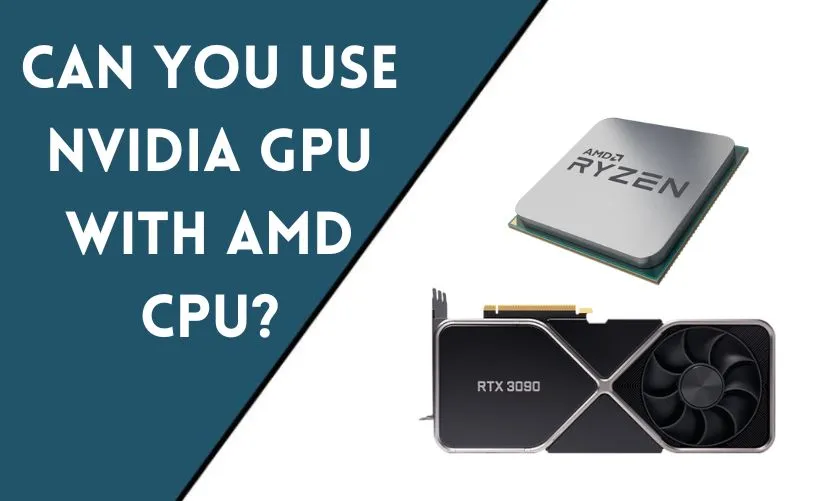
In the world of computer hardware, enthusiasts often ask the question, “Can you use an NVIDIA GPU with an AMD CPU?” It’s a valid question, as both NVIDIA and AMD produce some of the best graphics cards and processors on the market. This article will explore the compatibility between NVIDIA GPUs and AMD CPUs, discussing the advantages, disadvantages, and potential problems users may encounter.
Understanding Compatibility between NVIDIA GPUs and AMD CPUs
Before we dive into the details, let’s first understand the concept of compatibility between two different computer hardware components.
In the case of NVIDIA GPUs and AMD CPUs, they are two different components designed and manufactured by different companies. The compatibility of these two components depends on the system architecture, motherboard, and other hardware components installed in a computer.
Compatibility between NVIDIA GPUs and AMD CPUs is possible, but it depends on the type of motherboard and system architecture. The motherboard should have a PCI Express slot for the graphics card, and the system architecture should support the use of NVIDIA GPUs with AMD CPUs.
Advantages of Using NVIDIA GPU with AMD CPU
Using an NVIDIA GPU with an AMD CPU can have several advantages, including:
Enhanced Gaming Experience
NVIDIA GPUs are well-known for their superior gaming performance, with features like ray tracing and DLSS (Deep Learning Super Sampling). When combined with an AMD CPU, users can experience smoother gameplay, higher frame rates, and better graphics quality.
Efficient Video Editing and Rendering
If you are into video editing, rendering, or 3D modeling, combining an NVIDIA GPU with an AMD CPU can enhance the performance of your system. NVIDIA GPUs come with dedicated video encoding and decoding chips that can significantly reduce the time required to encode or decode high-quality videos.
Better Compatibility with Professional Software
Many professional software applications, such as Adobe Premiere Pro and Autodesk 3DS Max, are optimized for NVIDIA GPUs. By using an NVIDIA GPU with an AMD CPU, users can ensure better compatibility and optimal performance when running these applications.
Disadvantages of Using NVIDIA GPU with AMD CPU
While using an NVIDIA GPU with an AMD CPU can offer several benefits, there are some potential disadvantages to consider, including:
Compatibility Issues
Although compatibility between NVIDIA GPUs and AMD CPUs is possible, there can be compatibility issues when using them together. Some motherboard manufacturers may not provide proper support for using an NVIDIA GPU with an AMD CPU, which can lead to stability and performance issues.
Bottlenecking
In some cases, the performance of an NVIDIA GPU can be bottlenecked by an AMD CPU. This occurs when the CPU cannot keep up with the processing demands of the GPU, leading to decreased performance.
Increased Power Consumption
Using an NVIDIA GPU with an AMD CPU can increase the power consumption of a system, which can be a concern for users who are conscious of energy usage.
Potential Problems When Using NVIDIA GPU with AMD CPU
Apart from the advantages and disadvantages, there can be several potential problems when using an NVIDIA GPU with an AMD CPU. Some of these include:
Driver Compatibility
Using an NVIDIA GPU with an AMD CPU can require installing different drivers for each component. This can lead to conflicts and compatibility issues between the two components.
Overheating
Combining an NVIDIA GPU with an AMD CPU can lead to increased heat generation, which can result in overheating and damage to the components.
System Instability
In some cases, using an NVIDIA GPU with an AMD CPU can lead to system instability, crashes, and unexpected shutdowns.
Conclusion
In conclusion, using an NVIDIA GPU with an AMD CPU is possible, and it can offer several benefits, including enhanced gaming performance, efficient video editing, and better compatibility with professional software. However, users should also be aware of the potential disadvantages, compatibility issues, and potential problems that may arise when using these two components together. It’s important to research and ensure compatibility before purchasing components for a system.
Frequently Asked Questions
Can I use an NVIDIA GPU with an AMD CPU on any motherboard?
Compatibility depends on the motherboard and system architecture. Some motherboards may not provide proper support for using an NVIDIA GPU with an AMD CPU, leading to stability and performance issues.
Can combining an NVIDIA GPU with an AMD CPU increase power consumption?
Yes, using an NVIDIA GPU with an AMD CPU can increase the power consumption of a system. Users who are conscious of energy usage should consider this before using these components together.
Is there a risk of overheating when combining an NVIDIA GPU with an AMD CPU?
Combining an NVIDIA GPU with an AMD CPU can lead to increased heat generation, which can result in overheating and damage to the components. Proper cooling and ventilation are essential to prevent overheating.
Will using an NVIDIA GPU with an AMD CPU affect the compatibility with professional software?
Many professional software applications are optimized for NVIDIA GPUs, and using an NVIDIA GPU with an AMD CPU can ensure better compatibility and optimal performance when running these applications.
Is it necessary to install separate drivers for NVIDIA GPU and AMD CPU when using them together?
Yes, using an NVIDIA GPU with an AMD CPU can require installing different drivers for each component. It’s important to ensure compatibility and install the correct drivers to prevent conflicts and compatibility issues.










